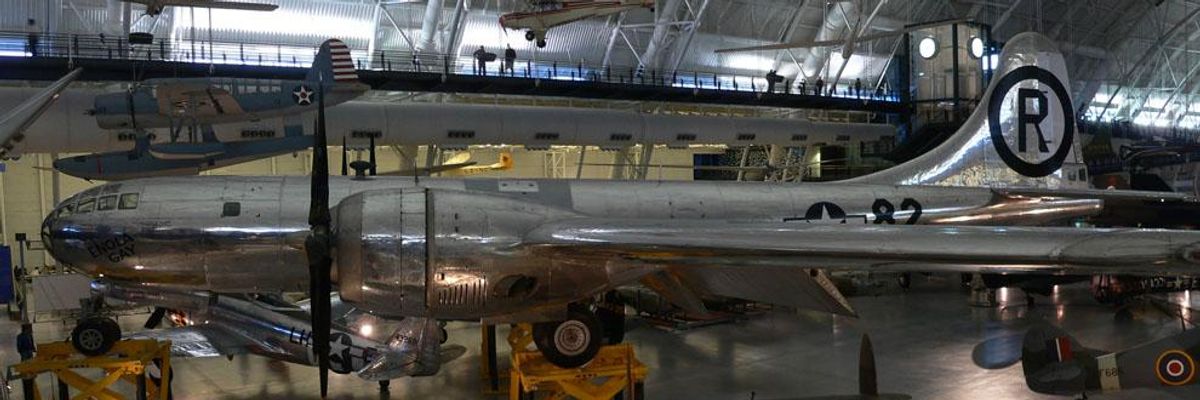This week, the Smithsonian's National Air and Space Museum unveiled a fully restored, finely polished artifact of World War II -- a Boeing B-29 "Superfortress." This particular airplane -- the Enola Gay -- is the centerpiece of the museum's sleek new $311-million annex.
Visitors to the museum will read a brief label identifying the Enola Gay as "the most sophisticated propeller-driven bomber of World War II, and the first bomber to house its crew in pressurized compartments."
Schoolchildren will learn that the plane's wingspan is 141 feet and 3 inches, and that it had a top speed of 339 mph.
But does such a history lesson justify a field trip to a museum? Isn't there something more important about the Enola Gay that our children should know?
Of course there is, and the museum's brief label provides a hint. Its final sentence notes, almost as an afterthought, that "On August 6, 1945, this Martin-built B-29-45-MO dropped the first atomic weapon used in combat on Hiroshima, Japan."
Some curious children might want to ask questions about that last sentence. What does an atomic bomb do when it is dropped? Why was one dropped on a city? What happened to the people in Hiroshima? Was it necessary to drop it?
The answers to these questions should be part of any American child's (and adult's) education, but retired Gen. John Dailey, the Air & Space Museum's director, insists that that aspect of their education is not the museum's responsibility: "We are displaying it [the Enola Gay] in all its glory as a magnificent technological achievement.... Our primary focus is that it was the most advanced aircraft in the world at the time."
In other words, the consequences of its historic mission are beside the point.
This is as ridiculous as it is disingenuous.
The Smithsonian doesn't limit its observations to technological advances when it displays weapons invented and used by other nations. The exhibit of Germany's V-2 is accompanied with photographs of the slave workers who built the rockets and the bodies of civilians killed by them.
Displaying the Enola Gay as just another B-29 is a charade -- undertaken because our national museum is afraid to deal honestly with the consequences of the plane's historic mission.
The first and most immediate of those consequences was the death of 140,000 people -- 95% of whom were civilians. After that, the consequences become contentious.
According to President Harry Truman, one direct consequence was the decision of the Japanese to surrender -- after the Soviet Union declared war on Japan on Aug. 8 and the U.S. dropped a second atomic bomb on the city of Nagasaki on Aug. 9. But others have insisted that the atomic bombings were not necessary to end the war.
It is an interesting and relevant fact that this controversy was initiated in 1945 by conservatives such as Time magazine publisher Henry Luce, Gen. Dwight D. Eisenhower, New York Times military correspondent Hanson Baldwin and David Lawrence, editor of U.S. News, who wrote in October 1945: "Competent testimony exists to prove that Japan was seeking to surrender many weeks before the atomic bomb came."
This is a view that historical research has confirmed. The discovery of President Truman's handwritten private diary, for example, revealed that on July 18, 1945, he had read a "telegram from Jap Emperor asking for peace.... Believe Japs will fold up before Russia comes in. I am sure they will when Manhattan [atomic bomb] appears over their homeland." And again, on Aug. 3, 1945, Walter Brown, an aide to Secretary of State James F. Byrnes, noted in his diary that Truman and his aides "agreed Japs looking for peace.... "
How nations deal with their histories can be an exacting litmus test of national character.
Throughout Asia, the Japanese are reviled for their dishonest refusal to acknowledge their barbarous behavior during their occupations of China, Korea and the countries of Southeast Asia. Our nation's uneasy relationship to the historical debate over the bombings of Hiroshima and Nagasaki is such a test and, despite history's patient annual re- administration of it, the U.S. has yet to achieve a passing grade.
As a result, we find ourselves -- ironically it must be said -- in the same remedial national history class as the Japanese. And we are certain to remain there, mocked by world opinion, as long as our misguided sense of American exceptionalism continues to dictate that public displays of American history be morally pure and patriotically correct.

